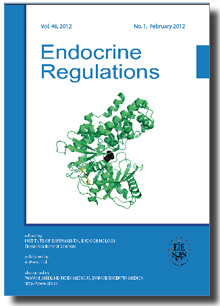Journal info
|
||
Select Journal
Journals
Bratislava Medical Journal Endocrine Regulations 2015 2014 2013 2012 2011 2010 2009 2008 2007 2006 2005 2004 2003 General Physiology and Biophysics Neoplasma Acta Virologica Studia Psychologica Cardiology Letters Psychológia a patopsych. dieťaťa Kovove Materialy-Metallic Materials Slovenská hudbaWebshop Cart
Your Cart is currently empty.
Info: Your browser does not accept cookies. To put products into your cart and purchase them you need to enable cookies.
Endocrine Regulations Vol.45, No.1, p.23-28, 2011 |
||
| Title: Expression of NIS in the thyroid and pituitary of female rats after a single dose of potassium iodide | ||
| Author: N. L. Basalaeva, G. V. Sychugov, V. K. Strizhikov, E. N. Mikhailova | ||
| Abstract: Objective. The aim of this work was to study the expression of NIS in the thyroid and anterior pituitary in rats after a single dose of iodide appropriate to the content of iodide in iodine-positive points in the thyroid and pituitary. Methods. A total of 41 inbred rat females of local laboratory strain weighing 250-300 g at the stage of diestrus and/or metestrus were used. Pituitaries and thyroids were dissected from 15 control rats at the same time as these from four groups of 6-8 rats each which were given various doses of potassium iodide dissolved in 0.5 ml distilled water (6 rats - 1 μg/100 g body weight; 8 rats - 4 μg/100 g ; 6 rats - 8 μg/100 g ; 6 rats - 25 μg/100 g.) by gavage at 48 h before sacrifice. In 6 rats of control group the concentration of iodine in thyroids and pituitaries was estimated in terms of percent by weight in dry tissue (wt% I-2 dry tissue) using the wavelength dispersive spectrometry (WDS) quantitative analysis. The expression of NIS in thyroids and pituitaries in terms of the percentage of positive immunostained area (% PA) was measured by streptavidin-biotin method using specific polyclonal antibodies. Results. In thyroids, the concentration of iodine in iodine-positive points ranged from 2.5 to 59.3 (mean of 16.7±3.0) in terms of wt% I-2 dry tissue (100 % iodine-positive points), while in pituitaries it ranged from 0.17 to 6.3 (mean of 1.4±0.3) in all points and 2.2±0.4 in iodine-positive points. Histochemical reaction for NIS in the pituitaries at 48 hours after iodide administration showed a dose related increase beginning from 4 μg/100 g (from 1.8±0.7 to 12.9±1.0 % PA, respectively to the dose of iodide), while such increase in the thyroids started from 8 μg/100g (from 3.7±1.2 to 9.1±2.0 % PA). It remained still increased in pituitaries after the dose of 8 μg/100g (11.4±1.0 % PA) and 25 μg/100g (13.9±1.5 % PA), while such increase in thyroids was found only after the dose of 25 μg/100g (11.9±2.8 % PA). Conclusion. It was found that in the pituitaries of rat females the expression of NIS started after the dose of 4 μg iodide/100g, while that in the thyroids started after 8 μg iodide/100g. Thus, it may be suggested that the pituitary appears more susceptible to the level of iodide in blood. |
||
| Keywords: WDS, NIS, iodide, pituitary, thyroid, rats | ||
| Year: 2011, Volume: 45, Issue: 1 | Page From: 23, Page To: 28 | |
| doi:10.4149/endo_2011_01_23 |
||
|
Price:
12.00 €
|
||
|
|
||

